Jack Byrne, a former Manchester City youth graduate, at 24 years old is a player that has experienced the difficult ups and downs of professional football on his journey to date. After a lack of first-team opportunity at Kilmarnock in 2018, Jack returned home to sign for Shamrock Rovers on 7th December 2018. With his attractive attacking style of play and willingness to take the ball, he has instilled himself quickly as a fan favourite at Shamrock Rovers. On the footballing front, the move home has been successful in raising the player’s profile and earning him consistent plaudits from football pundits. The most significant achievement in 2019 for Byrne has been his call up into the Ireland International team. On the 11th September 2019, Byrne came on as a substitute against Bulgaria and on November 19th he made his first senior start against New Zealand. The increase in profile has gained interest in Byrne outside of Ireland with a number of clubs tracking the player’s progress.
In this scout report, we will take a detailed look at Jack Byrne, focusing on several key technical and tactical areas of his game. We will initially begin with a tactical analysis of Byrne’s role within Shamrock Rover’s, his impact on the team, and how he fits into their tactics. After this, we will look at Byrne from the attacking perspective, the most important aspect of the central attacking midfielder’s game. Then we will analyse what he provides to a team on the defensive front and following this we will look at his involvement in set pieces. In the final part of the scout report, we will review what is next for Jack Byrne.
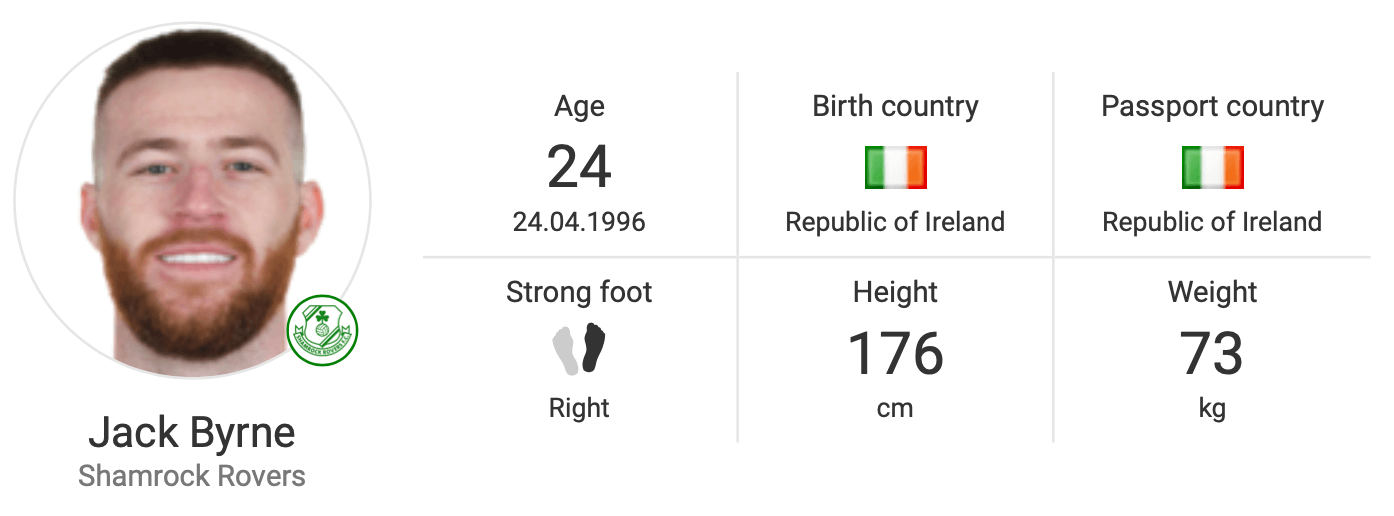
Jack Byrne’s role within Shamrock Rovers
Shamrock Rovers play primarily with a 3-4-1-2 or 3-5-2, and Byrne’s role in central midfield is distinctly clear as the connection between defence to attack. Rover’s manager Stephen Bradley plays to Byrne’s strengths, allowing him freedom of movement centrally when they are in possession. A testament to Byrne’s quality within the team is that the other players in the squad strive to get him on the ball during the game, specifically during the build-up. Byrne will consistently look to receive the ball from the defence, start attacks and then support it with positioning to receive further passes. This supportive role means that Byrne plays the conductor shaping and manoeuvring the attack to find defensive penetration. This positioning between the halfway line and the 18-yard box is illustrated in the player’s heat map below.

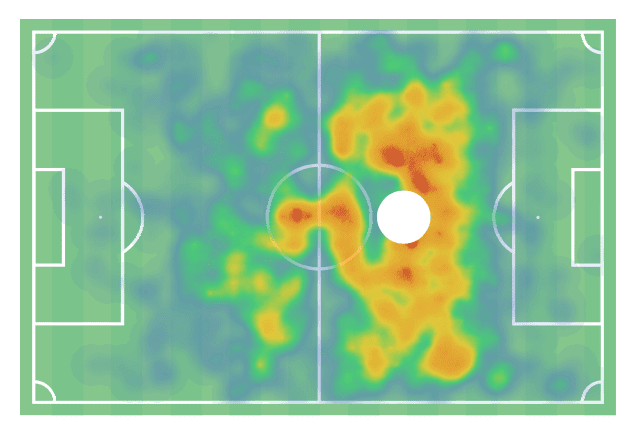
With Rovers implementing a high press game, the player’s impact is seen in other areas with key responsibilities in defending from the front. Another role he plays is as the primary set-piece taker for corner kicks and free kicks. It is justified to say that Byrne is the key player for Rovers, the statistics back this up and they also highlight the fact the player is leading the way from a league perspective. With regards to passing, deep completions, passes to final third, passes to the penalty area and progressive passes, Byrne is number one for each of those statistics in the league.
The below graph compares final third passes per 90 vs deep completions per 90 along with forward passes per 90 for the 2020 season, showcasing the primary penetrating attacking role Byrne plays within the Rover’s team. This graph also highlights the significant gap between Byrne and the other players in the league when it comes to generating these types of passes.
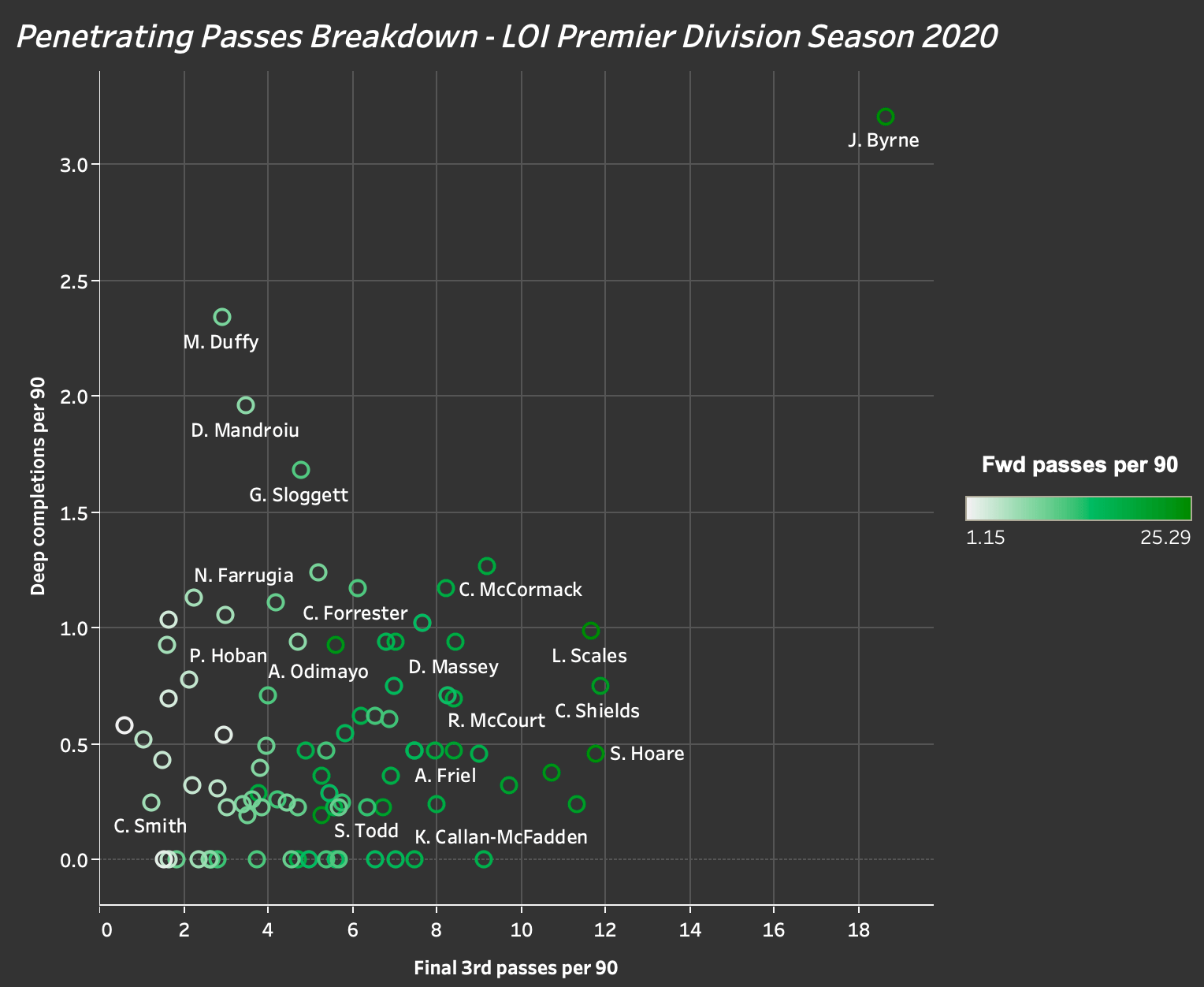
Game intelligence, awareness, and movement
Analysing Byrne’s attributes, the first one that stands out is his game intelligence and ability to use this reading of the game to create opportunities to receive the ball in space. He is continually scanning the pitch, analysing the play, and deciding on his positioning. This awareness is the foundation for his movement during attacking and defensive passages of play.
As expected with a central attacking midfielder, he will drop into space between the lines to receive the ball however he is notable for dropping into deeper positions towards the halfway line and picking up the ball from the centre-backs or central defensive midfielders. In the image below, Byrne drops into space as the ball is travelling whilst checking his shoulders to find forward passing options and ensuring he can receive the ball aware of any defensive pressure.
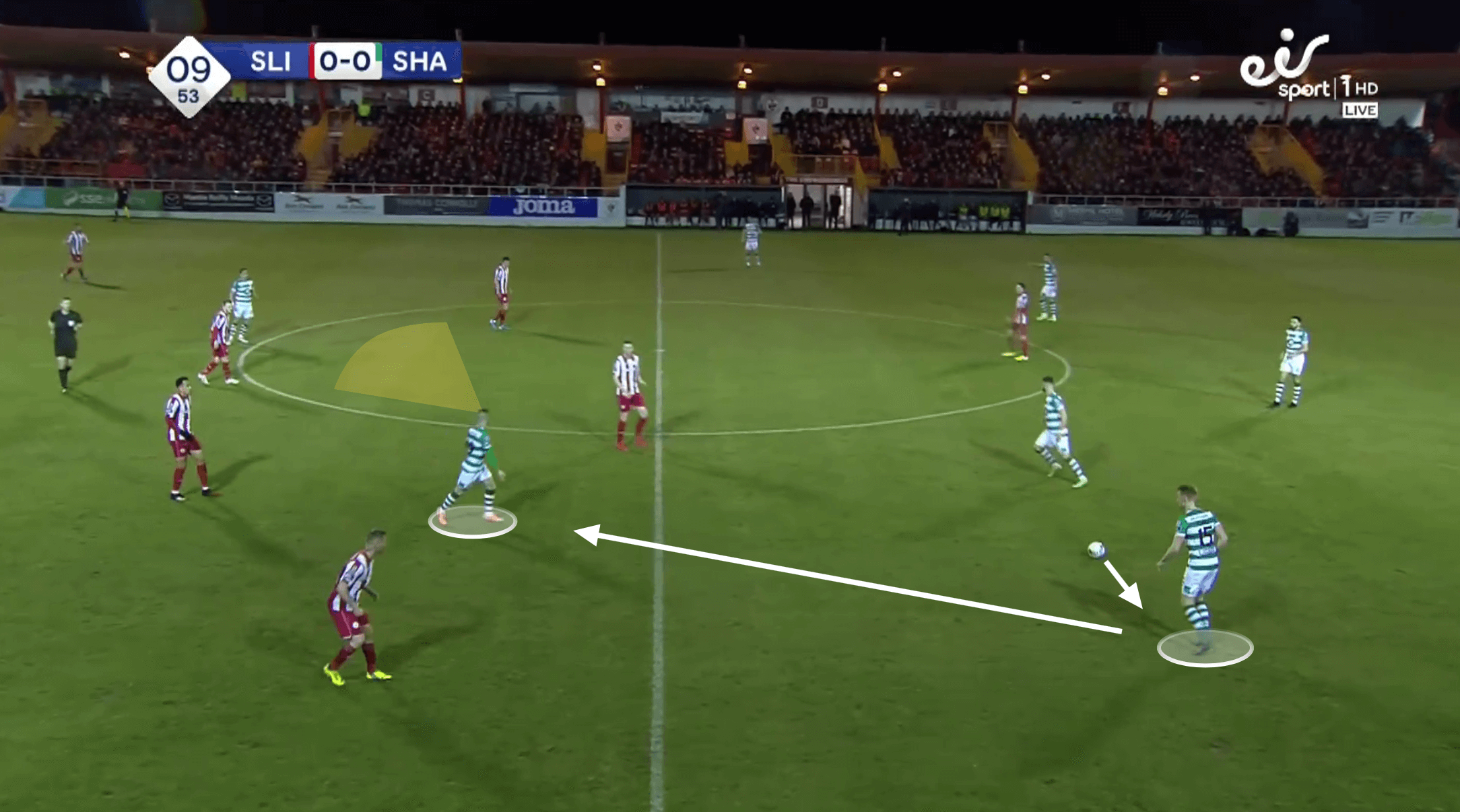
The movement after Byrne makes a pass forward is what distinguishes him from other players in this position in the league. After the pass forward, he will make a slight run forward, and the defender at this time that was pressing Byrne on the ball usually recovers back to the play. Then Byrne will halt or slow his run dropping off at an angle left or right in relation to the position of the player on the ball. It is in this movement that Byrne controls the attacking play in the final third as he is now in a position to support the attacker in receiving the ball back in free space.
This then leaves him with multiple options on the ball such as playing a cross, switching the play, penetrating pass into the box, or taking on a shot on goal himself. In the below image Byrne has made a forward pass to the player on the ball. At this moment Byrne begins to halt his run dropping at an angle and allowing the defenders to continue to run towards goal leaving him in space. He can now receive the ball back from the player in possession and has time to deliver a cross or shot.
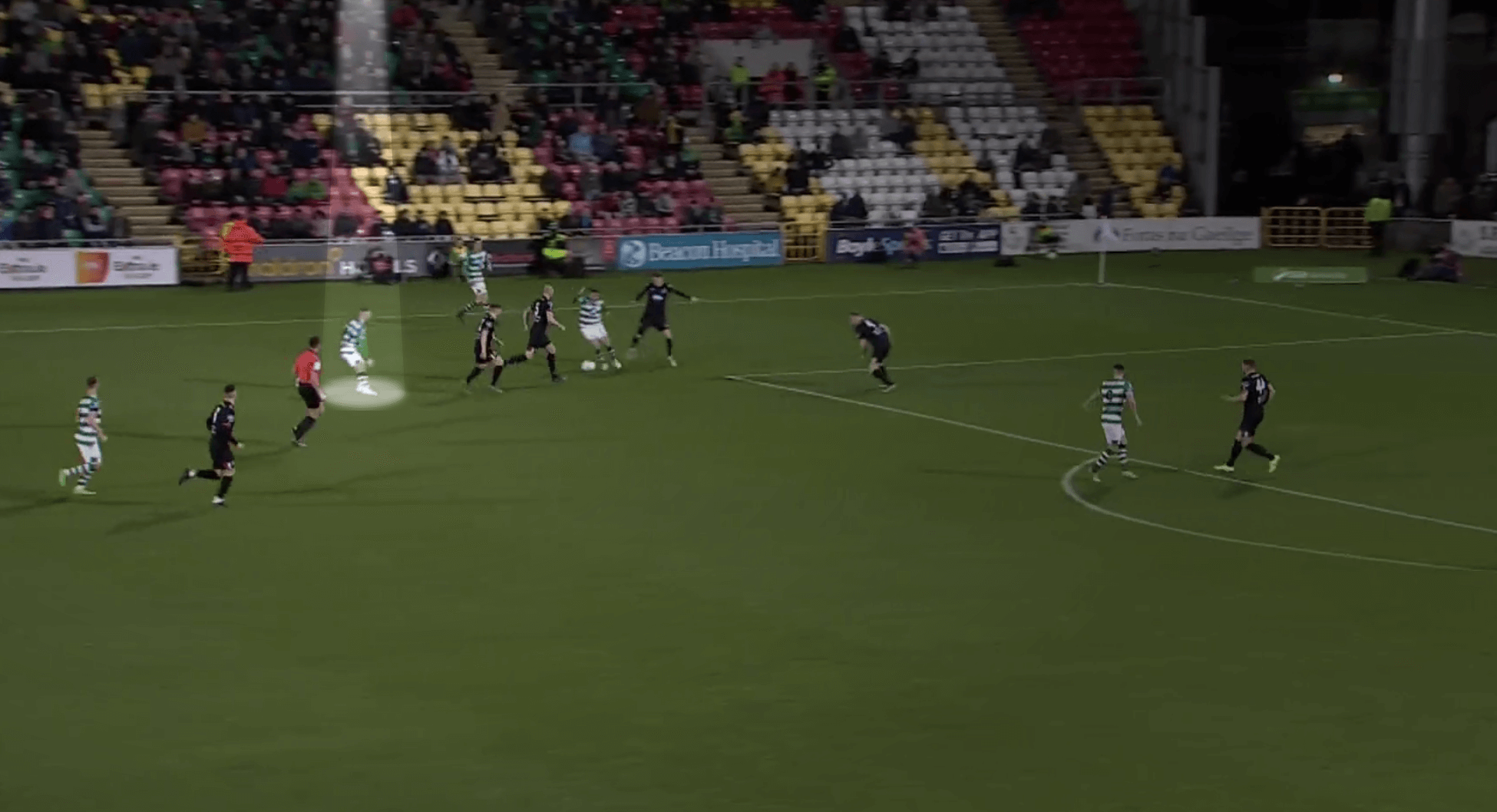
Byrne’s qualities on the ball
Averaging the highest number of passes per game in the league with 80 passes per 90 is an impressive statistic. When 18 of the 80 passes are into the final third and eight into the penalty spot, it is clear to see the attacking quality Byrne brings to Rover’s and the danger he presents in penetrating opposition defences. Byrne has a range of passes in his locker but looks to play them with a finesse, allowing the player receiving the ball to progress with little work in controlling the pass.
He is comfortable at using his weaker foot or if in tight spaces, he will at times use the outside of his right boot to complete slipped passes. From observing hundreds of passes his preferred passing location is from the right-hand side of the pitch within the middle third. In the graph below we can see the breakdown of player passes per 90 vs final third passes per 90 along with penalty area passes per 90 and Byrne is leading the way in the league across all three statistics.
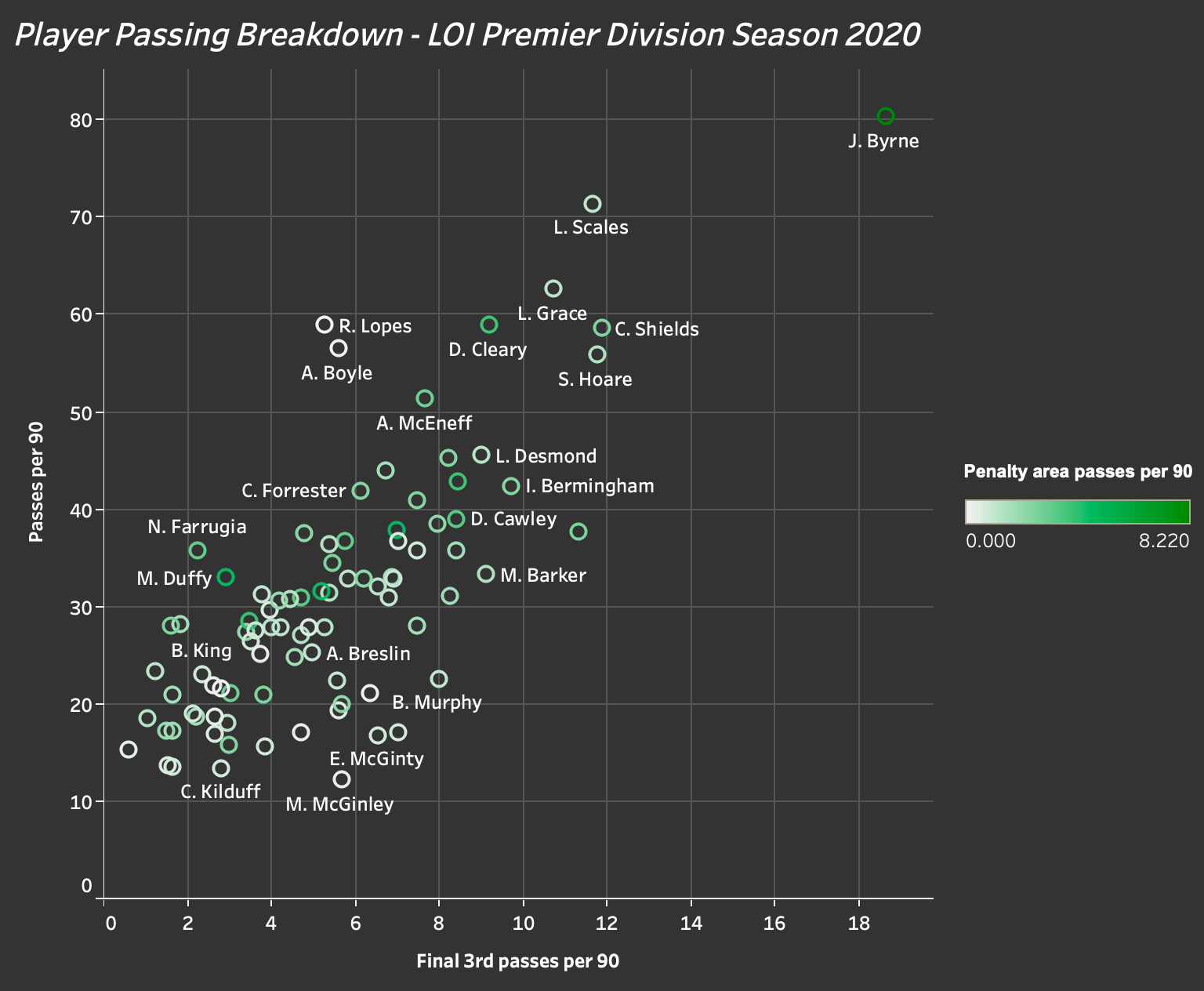
Long passes are another key skill of Byrnes as he is averaging 12 per game with 60% of those being successful. Upon analysing his long passes we can notice a difference in passes from right to left and passes from left to right. Long passes played from right to left have a lower trajectory with more pace but long passes played from left to right have a higher trajectory with less pace. This could be in part due to the body position being closed or open upon the impact of striking the ball.
For the opposition, this has an effect as the higher trajectory of the pass allows the defence to recover. It is also much more difficult for the player receiving the ball to control the pass successfully or progress first time with the ball. Another long pass that Byrne has a preference for is an over the full-back ball that he makes whilst moving laterally or backwards. In the image below we can see Byrne completing this pass successfully leading to Rover’s first goal in their recent game this season against Dundalk.
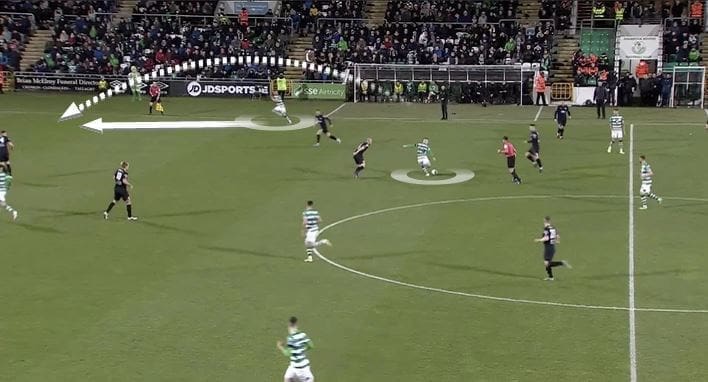
Byrne has an excellent first touch and is comfortable in control of the ball. Those abilities allow him to use his dribbling skills when required to gain space for a pass or a shot. In the final third of the pitch, five of Byrnes 11 dribbling runs this season have resulted in him taking a shot and from two of these shots, he has scored. We can see in the image below Byrne loses his marker Dundalk’s Chris Shield with a quick dribble across the box and scores with a curled shot to the bottom left corner from his left foot.
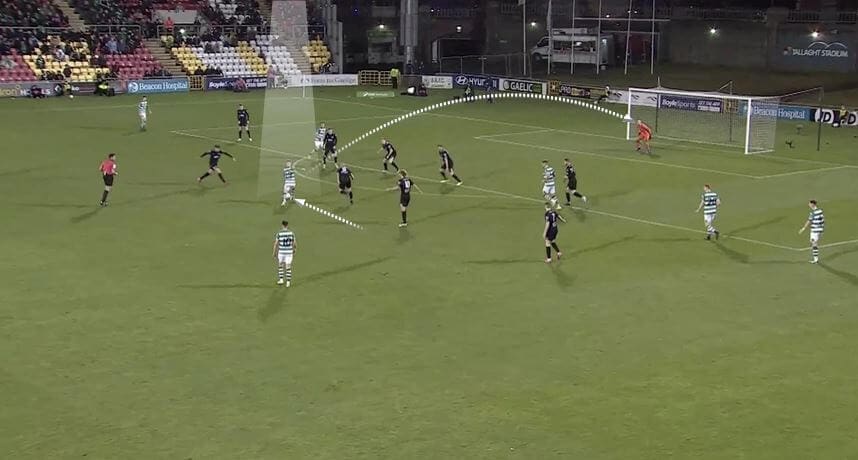
Byrne currently has an xG of 1.10 from this season and has scored three goals from five league games. From long-range Byrne has quite a collection of stand out goals. Due to his positioning, he can be in good locations to receive the ball for a shot and he utilises his footwork to give himself space to shoot. Over the past year, we can see in the image below a collection of his shots with the majority of the shots outside the box. Goals scored have come from shots from the centre or to the right of centre on the pitch.
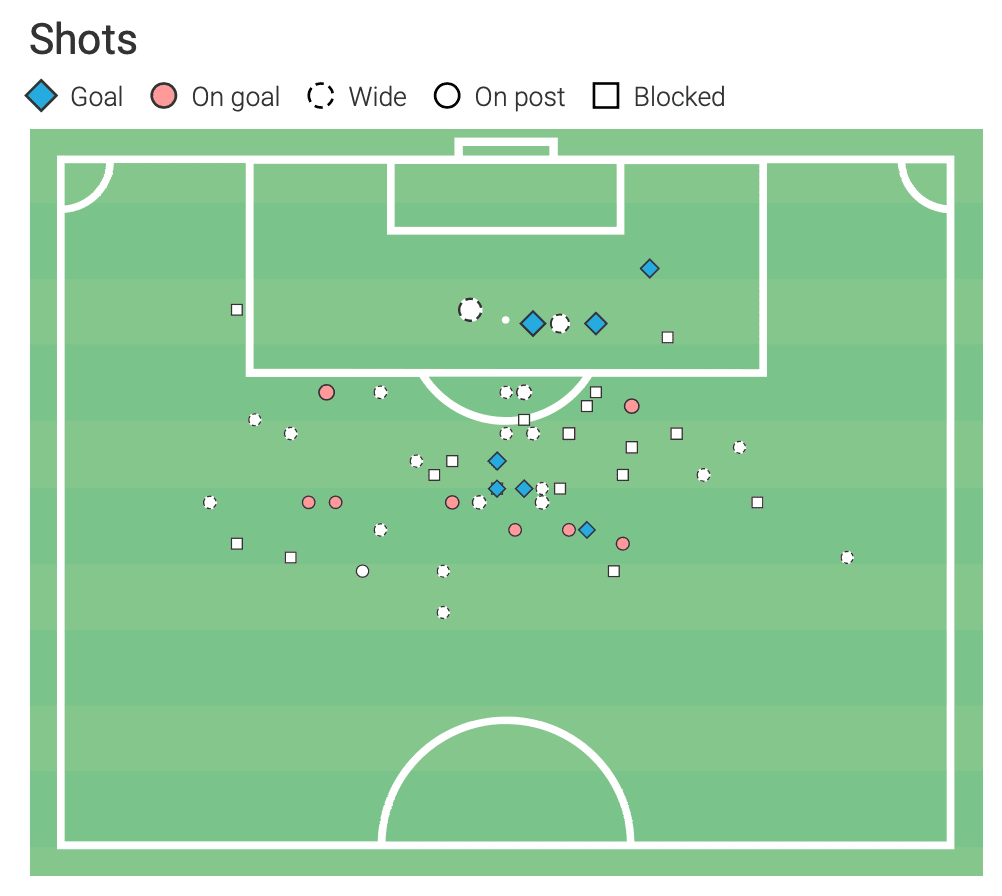
Taking a detailed look at the shot destination in the image below we can see that majority of shots specifically those scored are to the centre or left of the centre of the goal. Byrne is not limited to only shooting from one foot and if the opportunity arises he will use his left as can be seen in the breakdown below.
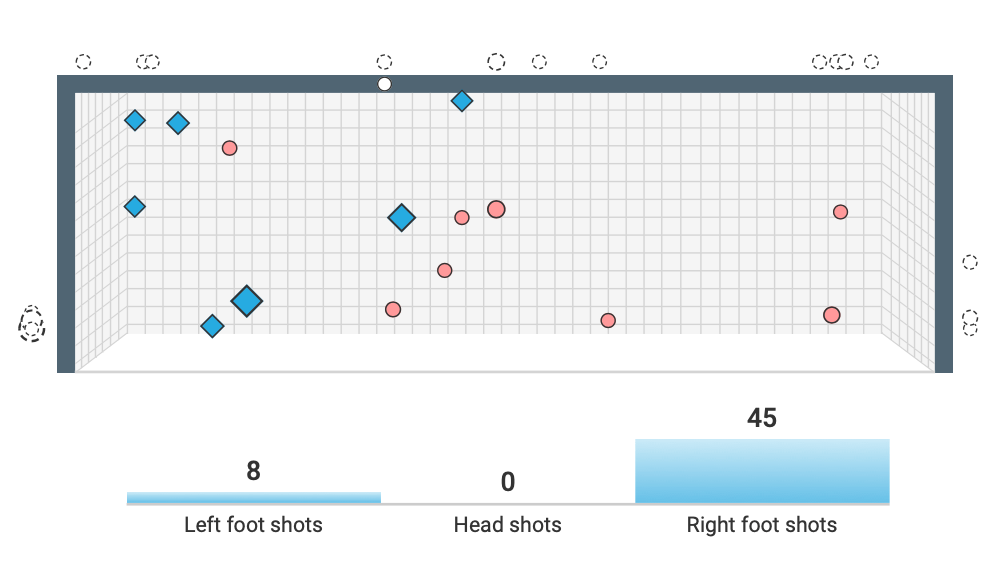
With regards to crossing Jack Byrne tops the statistics again with the total number taken for Rover’s this season. This is primarily due to his positioning along with the number of short corners Rover’s take in-game. With the short corners, he receives the ball back allowing him the opportunity to dribble further towards the goal to cross or cut the ball into the box. Byrne definitely creates more success from the right-hand side crosses than on the left-hand side.
In the below graph we see a comparison of crosses per 90 vs crossing accuracy with Neil Farrugia leading the way. Byrne has a consistent number of crosses per 90 but is below par with regards to accuracy and improving his crossing accuracy could be an opportunity area of improvement for him.
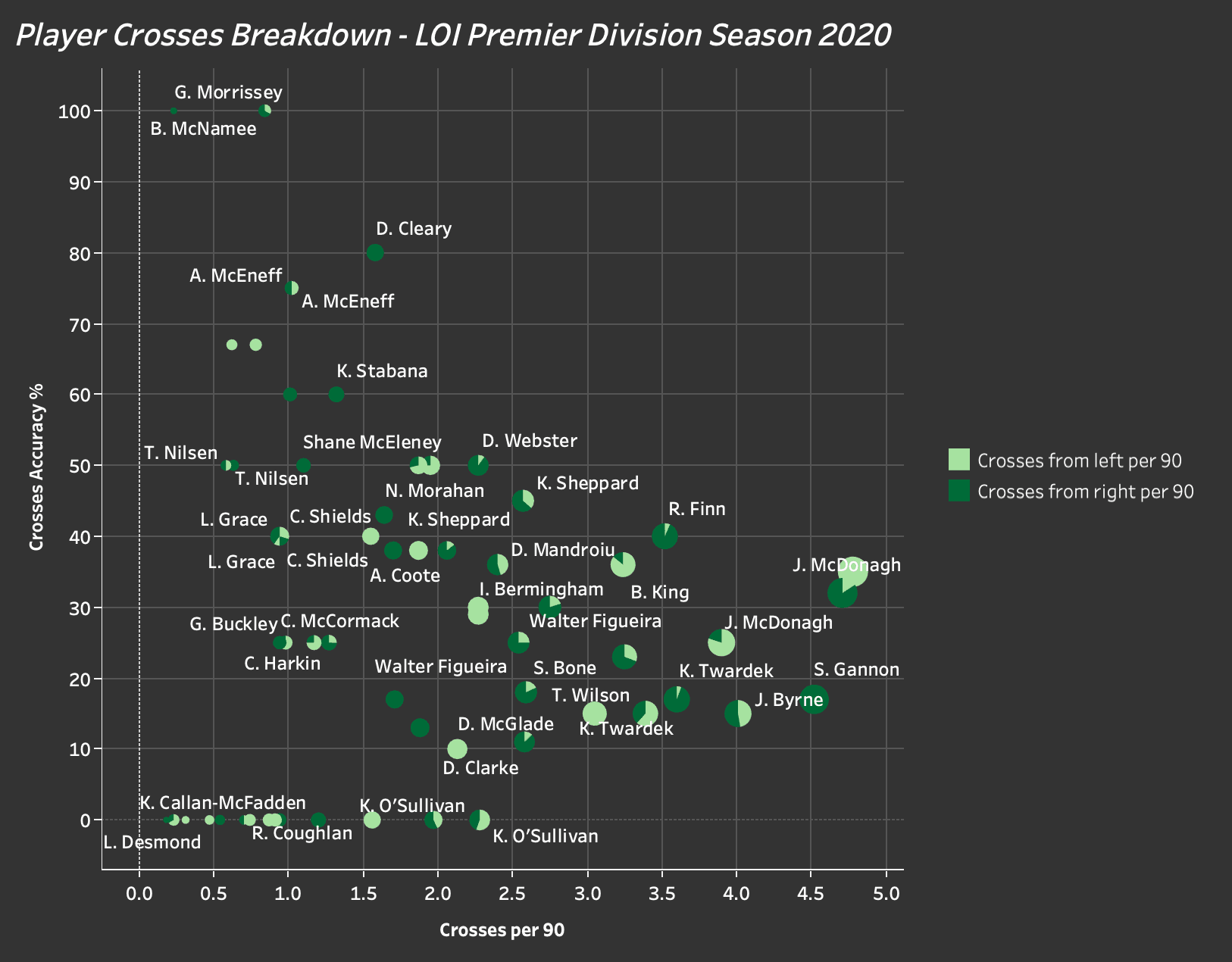
Key player on set pieces
In a recent article completing an analysis of all corner kicks taken in the League of Ireland this season, we found out that Shamrock Rover’s are in the top three for corner kicks with an xG of 0.64. Byrne plays a significant role during set pieces for them specifically on corner kicks, taking over 90% of corner kicks this season from both the left and right side of the pitch. Rover’s have a preference for short corners and in a 2v1 situation from a corner similar to the image below, Byrne is very skilled at creating danger by dribbling into the opponent’s box.
For attacking throw-ins, Byrne’s excellent first touch and control allow him to consistently retain possession, this can be very valuable especially under pressure in the final third of the pitch.
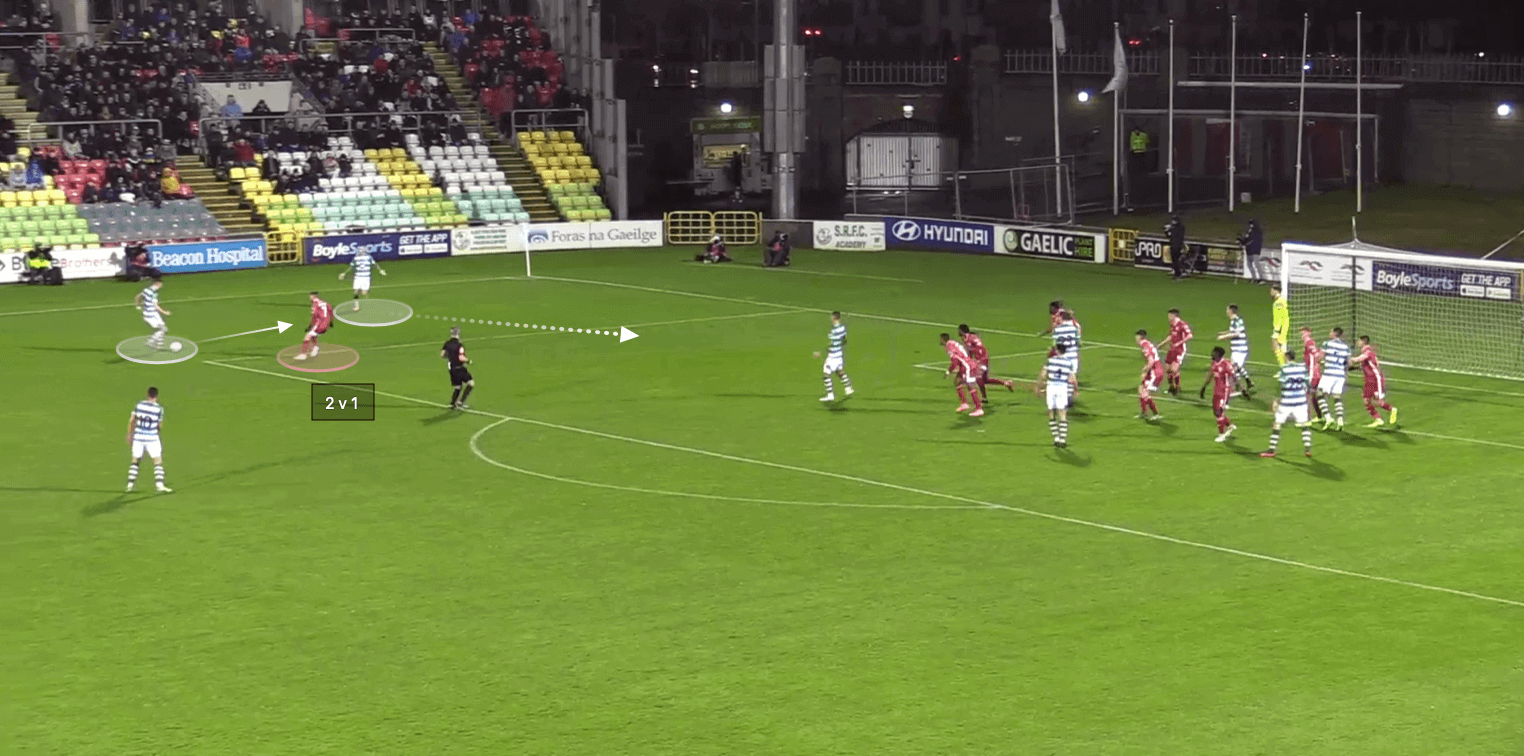
Impact during defensive phases
When analysing a central attacking midfielder it is rare to see high defensive statistics and Jack Byrne is no different in this regard statistically as what would be expected from this position. However, the difference with Jack Byrne becomes evident once you start watching video footage of Shamrock Rover’s opposition on the ball and start to focus on Byrne. He may not be putting event data statistics on the board however his defensive off the ball positioning, movement, and pressing is a significant factor in Rover’s recovering possession.
From the oppositions build-up phase, Byrne will pick up a position stopping any passes into a central midfielder that is dropping in to receive the ball from a centre-back. If a Rover’s line of defence is broken in the press he will quickly start recovering and pressing the opposition from behind into the Rover’s next line of defence as can be seen in the image below.
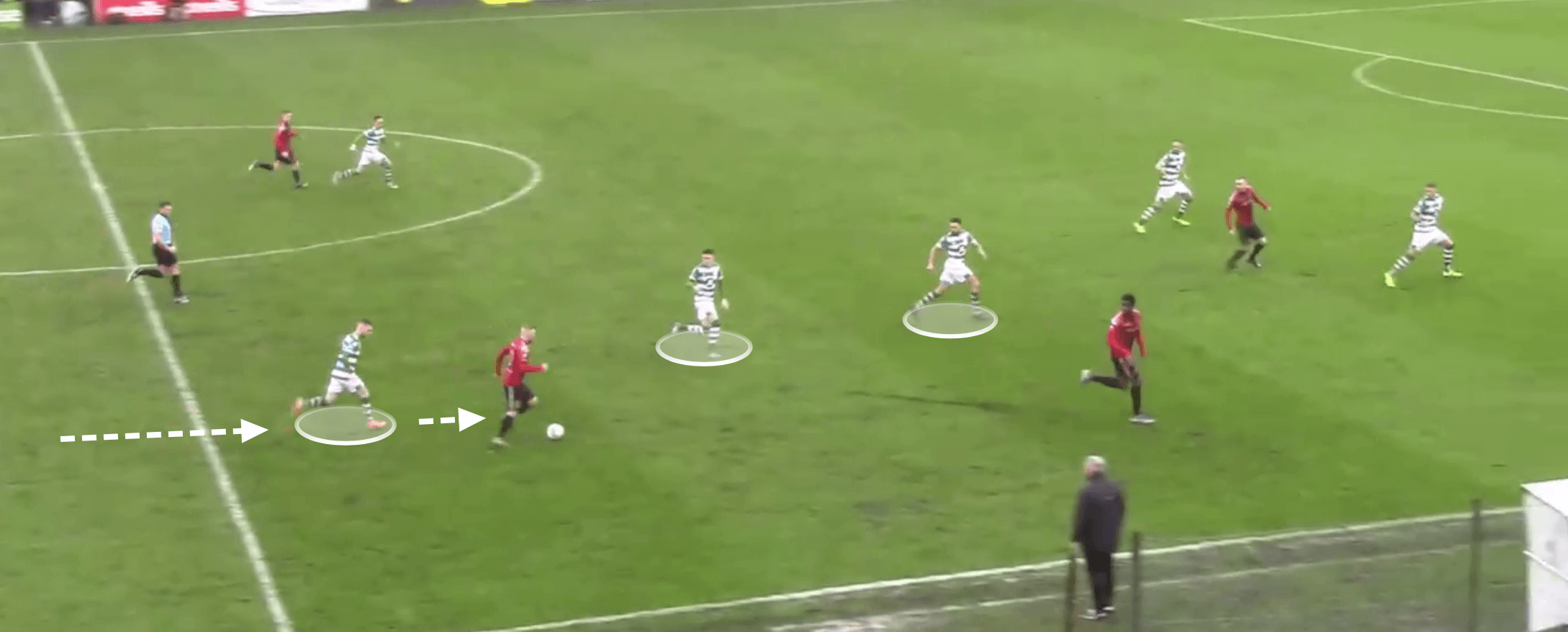
The stand out attribute in all of his defensive play is the consistency at which Byrne completes the pressing actions throughout every game. As discussed earlier Byrne has an excellent ability to read the game and this also comes into play when defending. At times when defending, he will take up defensive positions however he will also be aware of the transition to attack opportunities. In football, players at times when defending may try to mark the man and cover space at the same time to react to different actions within the game.
Byrne will complete the same action but the reason he picks a position between man marking and marking space is so that he can create an angle to receive the ball in a free passing lane quickly in space upon the transition to attack. In the below image we see Byrne take up this exact type of defensive position against Dundalk’s Chris Shields. Byrne is close enough to Shields to close him down if he receives a pass however if the ball is recovered for Rovers Byrne is looking to drop into the shaded area away from Shields to receive the ball.
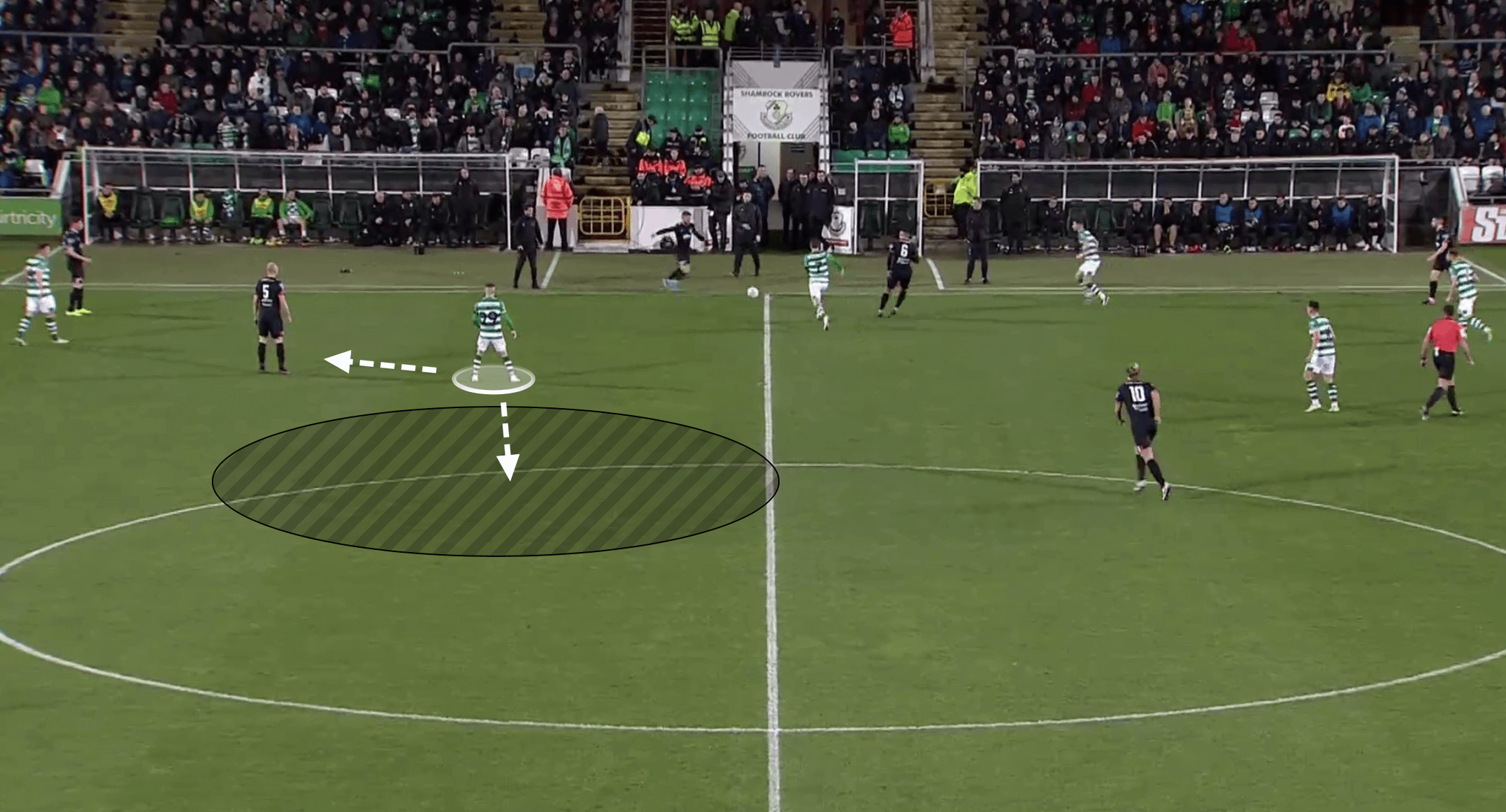
Conclusion
There is no doubt now that Jack Byrne made the best decision for his career and development in returning home to play football in the League of Ireland. The regular game time was definitely a factor in him finding consistent form along with the freedom to express himself creatively on the pitch with Shamrock Rover’s. The style of football he showcases week in week out gets noticed in the League of Ireland and I believe this has been a hugely positive factor increasing Byrne’s profile. As we know one of the minimum requirements for international managers selecting players is that the player being considered for selection is at least getting consistent game time. Shamrock Rover’s have given Byrne this platform and he is firmly striving in his role repaying their confidence with consistent performances.
If Byrne maintains the high level of performance showcased, opportunities will continue to arise for the recently turned 24-year-old. On the international front, Stephen Kenny has taken the role of Ireland international manager and may find Byrne a good fit for his passing style of football. Club level is where the real questions will be asked, Byrne will attract interest from overseas clubs. Will he be content with consistent game time competing in the League of Ireland or will the ambition to compete at a higher league level with all its uncertainty be worth another try abroad. The other side of the coin is if performances maintain or improve along with further international opportunities then Shamrock Rover’s may be forced to seriously weigh up the financial and team performance aspects of selling Jack Byrne as various teams across Europe and the Premier League start asking around.
He is an exceptional player in the League of Ireland and one that displays all the attributes required of a modern central attacking midfielder. His primary key strengths are his game intelligence, passing, movement to create space and awareness. He is suited for a ball playing team that builds up through the thirds maintaining possession who are requiring a player that can penetrate into the final third. Definitely a player I recommend for scouts and fans to keep track of when the football season returns.





Comments